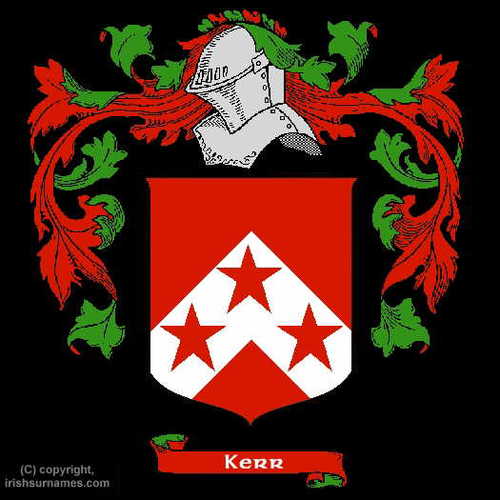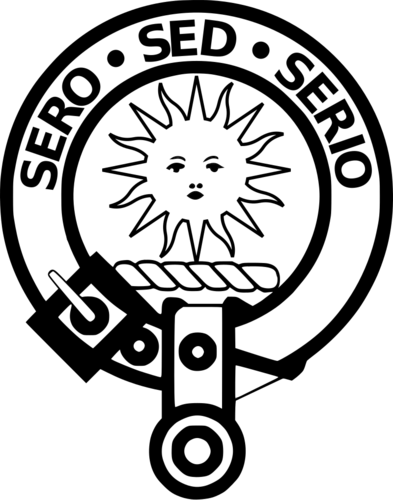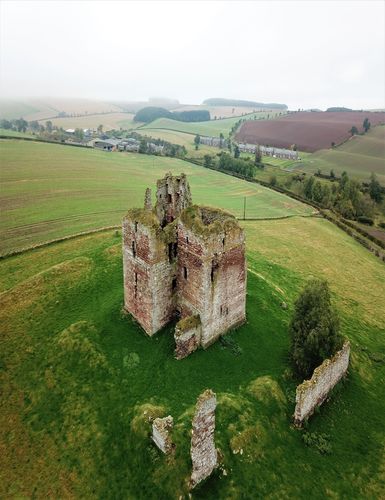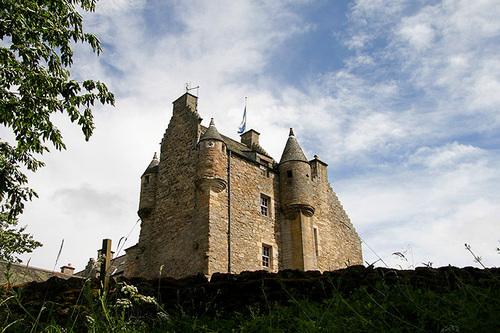KERR Family Tree
Welcome to the LINTON & BIRD Chronicles
KERR Family Tree
page established July 9, 2016 ![]()

Linton Research Fund Inc., Publication © 1987-2024 "Digging for our Roots"

KERR Family Tree
Charles KER-KERR (980–1049)
Terry Louis Linton © 2024
Linton Research Fund Inc., © 2024
LINTON & BIRD Chronicles Volume XVIV, Issue 2, Summer © 2024, ISSN 1941-3521
Charles KER-KERR (980–1049)
Charles KER-KERR (980–1049) is the Progenitor of our Kerr Family Tree. Charles was the 27th great-grandfather of Charles "Charlie" Edward LINTON (1890-1958) and the 28th great-grandfather of Kirk Louis LINTON (1914-1987) also 28th great-grandfather of Evelyn Virginia BIRD (1922-2012).
Charles KER-KERR (980–1020) was born circa 980 in Ker, Criel-sur-Mer, Dieppe, Normandy and died in 1020 in Ker, Criel-sur-Mer, Dieppe, Normandy.
The sea port of Criel was first recorded mentioned in 1059, as “Criolium”. It was again cited in 1326, the port was still operating in 1584.
Today, Criel-sur-Mer is the Seine-Maritime department in the Normandy region in northern France.
Criel-sur-Mer is a town of farming, tourism and light industry situated in the valley and at the mouth of the river Yères, some 12 miles (19 km) northeast of Dieppe. Its coastline is huge chalk cliffs that look out over the English Channel, At Criel, they rise to 107 meters.
Charles had one known son, William de KER-KERR (1022-1091) Baron Ayrshire who married Zoé de TREPORT (1025–?) ![]()
Surname Kerr The Kerr name meaning, according to the Dictionary of American Family Names © Patrick Hanks 2003, 2006: Kerr English and Scottish: topographic name for someone who lived by a marsh or swampy woodland, Middle English kerr ‘brushwood, wet ground’ (Old Norse kjarr). A legend grew up that the Kerrs were left-handed, on theory that the name is derived from Gaelic cearr ‘wrong-handed, left-handed’. Irish: variant of Carr . Americanized form of German Kehr or of some other similar (like-sounding) surname.

KERR Family Tree
Direct ancestral linage:
28th great-grandfather
Charles de KER-KERR (980–1049)
Children:
Rollo KER-KERR (1010–1100) "The Walker”; Charles KER-KERR (1015–1089); John KER-KERR (1018–1087); William de KER-KERR (1022-1091) Baron Ayrshire
|
|
27th great-grandparents
William de KER-KERR (1022-1091) Baron Ayrshire & Zoé de TREPORT (1025–?)
Children
William KER-KERR (1046–1066) Sir knight; Robert de KERR 1062–1124) Baron Ayrshire
|
|
26th great-grandparents
Robert de KERR (1062-1124) Sir knight & Joséphène de CUNNINGHAM (1068–1120)
Children
Zoé Ann KERR (1089–?); William KERR (1090–1111); Ralph KERR (1092–1158) Lord Ayrshire; Kirk KERR (1094–?); Kenneth KERR (1096–1145); Achard KERR (1098–1149)
|
|
25th great-grandparents
Ralph KERR (1092-1158) Lord Ayrshire & Juliette de DENWICK (1098–?)
Children:
Ralph KERR (1120–1181) Lord Denwick; Robert KERR (1122–1174) Baron Ayrshire & Lanark; Frederick KERR ((1124–1183) Lord Alnwick
|
|
24th great-grandparents
Robert KERR (1122-1174) Baron Ayrshire & Lanark & Ailis MORVILLE (1125–?)
Children:
Ralph KERR (1146–1174); Rollo KERR (1148–1194); Wilhite KERR (1150–?); Robert KERR (1152–1219) Baron Ayrshire; Juliette KERR (1155–1225); Ann KERR (1158–?)
|
|
23rd great-grandparents
Robert KERR (1152-1219) Baron Ayrshire & Elsie de HARTRIGGE (1158–?)
Children:
Stweart KERR (1180–1238); John KERR (1182–1248) Sheriff of Jedburgh; Anna KERR (1184–?); Elana KERR (1185–?)
|
|
22nd great-grandparents
John KERR (1182-1248) Sheriff of Jedburgh & Margaret PRINGE (1185–1237)
Children:
Jed KERR (1206–1259) Sir knight; John KERR (1208–1245) Sir knight; Robert KERR (1210–1263) Sir knight; Stephen KERR (1212–1276) Baron Holydean; Stweart KERR (1215-?) Lord Smailholm
|
|
21st great-grandparents
Stephen KERR (1212-1276) Baron Holydean & Annabel de HOLYDEAN (1215–1257)
Children:
Malcolm KERR (1237–?); Duncan KERR (1238–?); Douglas KERR (1240–1297) ; William KERR (1242–1305) Baron Jedburgh; Deirdre KERR (1244–?)
|
|
20th great-grandparents
William KERR (1242-1305) Baron Jedburgh & Hanna de GALKNOWE (1244–1280)
Children:
Stephen KERR (1260–1324); Annabel KERR (1262–?); Euphemia KERR (1264–?)
|
|
19th great-grandparents
Stephen KERR (1260-1324) Lord Jedburgh & Mary de YETHOLM (1266–1320)
Children
Hanna KERR (1290–?); Kenzie KERR (1295–?); Catriona KERR (1297–?): William KERR (1300–1364)
|
|
18th great-grandparents
William KERR (1300-1364) Warden of Marches & Margaret HOEDEN (1308–1353)
Children:
Mary Elizabeth KERR (1327–?); Stephen KERR (1329–1369); Margaret KERR (1331–?); Isla KERR (1332–?); Flona KERR (1334–?); Effie KERR (1335–?); Thomas KERR (1337–1389)
|
|
17th great-grandparents
Thomas KERR (1337-1389) Baron, Warden of Marches & Elizabeth de HOME (1335–1395)
Children:
Andrew KERR (1356–1398); John KERR (1358–1418); Homes KERR (1360–1407); Kenneth KERR (1362–?); William KERR (1366–?)
|
|
16th great-grandparents
Andrew KERR (1356-1398) Knight of Shire Jedburgh & Jean CRICHTON (1357–1399)
Children:
Jean KERR (1382–?); Andrew KERR (1386–1481); Edward KERR (1388–?); Ralph KERR (1392–1444)
|
|
15th great-grandparents
Andrew KERR (1386-1481) Knight of the Shire of Auldtounburn and Cessford &
Margaret TWEEDIE (1397–1440) Lady
Children
John KERR (1417–?); Andrew KERR (1420–?); Margaret KERR (1422–?); William KERR (1425–?); Thomas KERR (1430–1484)
|
|
14th great-grandparents
Thomas KERR (1430-1484) Knight of the Shire for Smailholm & Ferniehirst &
Margaret DOUGLAS (1425–1484) Lady Cessford
Children:
Thomas KERR (1448–1484); James KERR (1450–?); William KERR (1451–?); Alexander KERR (1453–1516
|
|
12th great-grandparents
Thomas KERR (1450-1484) Sir knight & Catherine COVILLE (1450–1484) Heiress
Children:
Andrew KERR (1471–1545) Baron of Ferniehurst; Margaret KERR (1474–1484)
|
|
11th great-grandparents
Andrew KERR (1471-1545) Baron of Ferniehurst &
Janet HOME (1475–1543)
Children:
Janet KERR (1494–1546); John KERR (1500–1562); Thomas KERR (1502–1524); Elizabeth KERR (1503–?); Caterine KERR (1504–1548); Christian KERR (1507–1558); Margaret KERR (1508–1585); Walter KARR (1510–1581); Isabel KERR (1515–1585); Mark KERR (1516–1584); Robert KERR (1518–1588)
|
|
10th great-grandparents
Walter KARR (1510-1581) Lord van Cessford &
“Isabel” Isabelle CESSFORD (1515–1585) Lady Cessford
Children:
Margaretha “Margaret” KERR 1535–1589) Lady Fermiehurst, Countess Kerr; Walter Cessford KARR (1543–1601) Lord Kerr van Cessford; Willem KERR (1545-? Lord van Cessford.
|
|
9th great-grandparents
Margaretha “Margaret” KERR (1535-1589) Lady Ferniehurst, Countess Kerr &
Walter LINTON (1533–1633) Earl of Traquair, Lord Commissioner of the Treasury
Children:
John LINTON (1560–1632) Baron Caberston; Arthur LINTON (1562–1646) Lord
|
|
8th great-grandparents
John LINTON (1560-1632) Baron Caberston & Rebecca CABERSTON (1565-1634)
Children:
Arthur LINTON (1590–1646); Thomas LINTON (1592–1653); Robert LINTON (1600–1674)
|
|
7th great-grandparents
Arthur LINTON (1590-1646) Baron of Caberston & Isabella CURRIE (1592–1662)
children:
Arthur LINTON (1614-1662) & John LINTON (1616-?)
|
|
6th great-grandparents
Arthur LINTON (1622-1696) Baron Lowe Crosby & Elizabeth KIRKBRIDE (1622–1670)
children:
Roger LINTON (1641–1715); Arthur LINTON (1648–1708); John LINTON (1650–1709); Thomas LINTON (1660–?)
|
|
5th great-grandparents
Roger LINTON (1641-1715) Baron & Dorothy NEWBERGH (1641-1681)
children:
Sir Knight Roger LINTON (1660–1753) physician; James LINTON (1661–1730); John LINTON (1662–1709) emigrate; Benjamin LINTON (1664–1709) emigrant; David LINTON (1665–1739) emigrant; Anne LINTON (1667–?); Jacob LINTON (1670–1709) emigrant; Samuel LINTON (1675–1753) emigrant.
|
|
4th great-grandparents
John LINTON (1662-1709) & Rebecca RELF (1672-1714)
Quaker emigrants
children:
Sarah LINTON (1692-1692); Anna LINTON (1694-1699); Mary LINTON Blackshaw (1695-1769); Joseph LINTON (1697–1747); Benjamin LINTON (1703-1773); John LINTON (1706-1761)
|
|
3rd great-grandparents
Isaiah LINTON (1739-1775) master millwright & Sarah HIRST (1742-1823)
children:
Laura Ellicott LINTON (1766-1825); Thomas LINTON (1768-1829); James LINTON (1764-1854); William LINTON (1772-1848); Sarah LINTON (1774-1817)
|
|
2nd great-grandparents
James LINTON (1769-1854) & Ann CROASDALE (1776-1852)
children:
George Croasdale LINTON (1802-1863); Lewis Colbert LINTON (1803-1876); Maurice Peter LINTON (1807-1872); Robert Henry LINTON (1809-1884); James LINTON, Jr. (1812 ?); Ann Croasdale LINTON (1815-1895); Deborah Caroline LINTON Ridge (1819-1894); Jeremiah Croasdale LINTON (1821- ?)
|
|
great-grandparents
Doctor Lewis Colbert LINTON (1803-1876) & Sarah KOCHER (1810-1870)
children:
Mary Ann LINTON Jenkins (1828-1876); Emma Caroline LINTON Mendler Smith (1829-1909) ; Harriet LINTON Fuller King (1831-1912); Deborah Caroline LINTON Fowler (1834-1916); John Edward LINTON (1838-1901); Jerome D. LINTON (1839-1910); Francis "Frank" Charles LINTON (1844-1911); Morris LINTON (1848-1860)
|
|
Grandparents
John Edward LINTON (1838-1901) & Sallie Fenmor STONESTREET (1861-1928)
children:
Charles Edward LINTON (1890-1958)
& half-brother George Whippoorwill Stonestreet PHILLIPS (1904-1969)
|
|
Parents
Charles Edward LINTON (1890-1958) & Annie Lucretia CRONK (1888-1956)
children:
John Edward Charles LINTON (1910-1911); Florence Avis LINTON Beavers (1912-1990); Kirk Louis LINTON (1914-1987); Georganna LINTON (1916-1916); Theodore "Ted" Francis LINTON (1917-1970); Bernadette "Bernie" Thelma LINTON Butler (1921-2014); Madeline "Madge" Elizabeth LINTON Bly (1922-1991)
|
|
Kirk Louis LINTON (1914-1987) & Evelyn Virginia BIRD (1922-2012)
children
Kenneth "Ken" Edward LINTON (1945) & Terry Louis LINTON (1949)
Clan Kerr Badge
Crest: The sun in his splendour Or
Motto Sero sed serio (Late but in earnest)
Slogan Late but in Earnest
Profile
District Scottish Borders
Plant badge Bog Myrtle
Wikipedia, the free encyclopedia
Creative Commons Attribution-ShareAlike License 4.0
Terry Louis Linton Wikipedia contributor
Clan Kerr (/kɜːr/ ⓘ) is a Scottish clan whose origins lie in the Scottish Borders. During the Middle Ages, it was one of the prominent border reiver clans along the present-day Anglo-Scottish border and played an important role in the history of the Border country of Scotland.
Origins of the clan
The name Kerr is rendered in various forms such as Kerr, Ker, Kear, Carr, Carre,[5] and Cares.[4] The name stems from the Old Norse kjarr which means marsh dweller, and came to Scotland from Normandy, the French settlement of the Norsemen.[5] Another variant is found on the west coast of Scotland, particularly on the Isle of Arran, taken from the Gaelic ciar, meaning dusky.[5] The early Roxburghshire Kerrs had their origins in the 12th century Ayrshire bailiery of Cunninghame. During the reign of David I (1082–1153), Hugh de Morville, Lord High Constable of Scotland, granted lands in Cunninghame to the Norman family of William de Ker. These lands became known as Kersland.[6] At this time, Cunninghame was under the control of de Morville who also maintained the nearby port of Irvine – one of Scotland's earliest capitals – as his military headquarters.
Hugh de Morville hailed from the Normandy town of Morville. In an era when noble families defined themselves by their location of origin, it is conceivable that the roots of the family of William de Ker (William from Ker) lie in a town bearing the name of Ker. Though speculative, this could be the Normandy town of Criel, renamed Criel-sur-Mer in 1902. According to a publication from 1740: "Ker veut dire une maison; & je crois que le nom du bourg de Criel en est derivé..." ("Ker means a house; and I think that the name of the village of Criel is derived from it...")[7]
William de Ker's grandson is said to have been allied to Sir William Wallace in the struggle for Scottish independence: "William Ker of Kersland joined Wallace in 1296. He and Stephen of Ireland are said to have been the only two of Wallace's men who survived the battle of Elcho. Ker was the constant friend and companion of Wallace. In 1305, when Wallace was taken prisoner at Robroyston, William Ker only was with him. They were found both asleep, and Ker was unfortunately killed in the scuffle".[8]
Family tradition asserts the Norman origin for the chiefs comes from two brothers, Ralph and Robert (also called John), who came to Roxburgh from Lancashire.[5] It has never been confirmed who was the elder, although the senior branch of the family, the Kerrs of Ferniehurst claim descent from Ralph, while their rivals, the Kerrs of Cessford, descended from John.[5]
Asked how to say his name, Admiral Mark Kerr told The Literary Digest in 1935, "In Scotland the name rhymes with care. Since many of the family have come to England the pronunciation in this country rhymes with car, which we have entirely submitted to."[9] Another common pronunciation of Kerr, such as in the majority of the United States, is "kur".[10]
15th and 16th century clan conflicts
The two main branches of the Clan Kerr, the Kerrs of Ferniehurst and the Kerrs of Cessford, often feuded with each other.[11] However, both Andrew Kerr of Ferniehurst and Andrew Kerr of Cessford were made Wardens of the Middle Marches,[11] the first in 1502 and the latter after the Battle of Flodden in 1513.[11] After Flodden, some of the Liddesdale clans put themselves under the Kerr of Ferniehurst's protection, but, in 1523, his castle was captured by an English force after a protracted defence.
The Clan Kerr feuded in particular with the Clan Scott.[12] The feud began on 25 July 1526, when Sir Walter Scott of Buccleuch launched an attack (the Battle of Melrose) to rescue the young James V of Scotland who was being held by the Douglas Earl of Angus at Darnick just west of Melrose, and in the ensuing fight Kerr of Cessford was killed.[12] The Kerrs, however, took their time and, in 1552, they set upon Sir Walter Scott on Edinburgh High Street and killed him.[12] The feud came to an end when Sir Thomas Kerr of Ferniehirst married Janet Scott who was the sister of the tenth Scott Laird of Buccleuch.[12]
Mark Kerr had his lands of Newbattle and Prestongrange erected into the barony of Newbattle by a charter of 1591.[5]
17th century and Civil War
In 1606, Mark Kerr was created Earl of Lothian.[12] This title failed when his son died in 1624 without male issue.[5] In 1621, Sir Andrew Kerr of Ferniehurst was created Lord Jedburgh.[5]
The third peerage to come to the family was the earldom of Ancram, which was given to Sir Robert Kerr, a descendant of a younger son of Sir Andrew Kerr of Ferniehurst.[5] In 1616, Sir Robert Ker of Cessford, by this time spelt his surname with a single 'r', was created Earl of Roxburghe.[5] In 1631, Sir William Kerr, son of the Earl of Ancram, was granted a new earldom of Lothian in 1631.[5] His son was Robert Kerr who was advanced to the rank of marquess and who also succeeded to the earldom of Ancram on the death of his uncle.[5]
During the Scottish Civil War, Colonel Kerr supported the Covenanter commander, General David Leslie, Lord Newark, and took the Clan Mackenzie's Redcastle, demolished it, and hanged the garrison.[13]
18th century and Jacobite risings
Lord Mark Kerr, son of the Chief, Robert Kerr, 1st Marquis of Lothian, was a distinguished professional soldier and is reputed to have had a high sense of personal honour and a quick temper.[5] He fought several duels throughout his military career but rose ultimately to the rank of general, and was appointed governor of Edinburgh Castle in 1745.[5]
During the Jacobite rising of 1745, the Clan Kerr supported the British government. At the Battle of Culloden in 1746, Lord Kerr's great nephew, Lord Robert Kerr (son of William Kerr, 3rd Marquis of Lothian), who was Captain of the grenadiers in Barrell's regiment, received the first charging Cameron on the point of his Spontoon, but a second cut him through the head to chin.[5] He has the dubious distinction of being the only person of high rank killed on the government side.[5] The eldest of the brothers, Mark, Lord Kerr, later the fourth Marquess of Lothian, commanded three squadrons of government cavalry at the Battle of Culloden and survived to serve under the Duke of Cumberland in France in 1758.[5]
Left-handedness
The Kerrs have typically been associated with left-handedness, and some of their buildings, such as Ferniehirst Castle, have turnpike stairs explicitly designed with this in mind.[14][15] Andrew Ker (1471–1545), known as Dand,[16] developed Ferniehirst into a formidable stronghold. Both Dand and his paternal grandfather, Andrew of Cessford, are believed to have been left-handed swordsmen. A left-handed mercenary warrior could command a higher fee for his services, and those who fought under the Ferniehirst and Cessford banners were encouraged to fight "ker-handed".[17]
There is an anecdotal link between the Kerrs and left-handedness. An article in the British Medical Journal around 1972 stated that about 30% of those with the surname Kerr were left-handed, compared to 11% as the world's population. However, a 1993 study found no statistically significant increase in left-handedness among people with the family name Kerr or Carr.[18]
Notes and references
- ^ Jump up to:a b c Clan Kerr Profile scotclans.com. Retrieved 10 December 2013.
- ^ Jump up to:a b c d e Coventry, Martin (2008). Castles of the Clans: The Strongholds and Seats of 750 Scottish Families and Clans. Musselburgh: Goblinshead. pp. 305–308. ISBN 978-1-899874-36-1.
- ^ Jump up to:a b c d Scots Kith & Kin. HarperCollins. 2014. p. 63. ISBN 9780007551798.
- ^ Jump up to:a b Lower, Mark A (1860) Patronymica Britannica: a dictionary of the family names of the United Kingdom. London: J.R. Smith. Public Domain. p. 52.
- ^ Jump up to:a b c d e f g h i j k l m n o p q Way, George of Plean; Squire, Romilly of Rubislaw (1994). Collins Scottish Clan & Family Encyclopedia. Glasgow: HarperCollins (for the Standing Council of Scottish Chiefs). pp. 184–185. ISBN 0-00-470547-5.
- ^ Lawson, Bob (2014). The Kerrs of Ferniehirst 1205–1692. Self-published. p. 4.
- ^ Dom. Toussaints du Plessis (1740). Description géographique et historique de la haute Normandie.
- ^ Cowan, J.P., Samuel (1904). The Ancient Capital of Scotland: The Story of Perth from the Invasion of Agricola to the Passing of the Reform Bill. Vol. I, chapter VIII. New York: James Pott & Co.
- ^ Charles Earle Funk, What's the Name, Please?, Funk & Wagnalls, 1936.
- ^ "What's In A Name?". Kerr Family Association of North America. Retrieved 20 May 2022.
- ^ Jump up to:a b c Clan Kerr History electricscotland.com. Retrieved 11, February 2013
- ^ Jump up to:a b c d e Way, George of Plean; Squire, Romilly of Rubislaw (1994). Collins Scottish Clan & Family Encyclopedia. Glasgow: HarperCollins (for the Standing Council of Scottish Chiefs). pp. 314–315. ISBN 0-00-470547-5.
- ^ Mackenzie, Alan (2006) History of the Mackenzies Chapter 9. p. 105. Retrieved 10 December 2013.
- ^ Kerr (Car or Ker) scottish places.info. Retrieved 10 December 2013.
- ^ "Ferniehirst". The Castles of Scotland Goblinshead Martin Coventry. 23 January 2019. Retrieved 31 March 2019.
- ^ "Dand Kerr 1480–1545". clankerr.co.uk. Retrieved 13 December 2019.
- ^ Lawson, Bob (2014). The Kerrs of Ferniehirst 1205–1692. Self-published. p. 24.
- ^ Shaw, D.; McManus, I. C. (1993). "The handedness of Kerrs and Carrs". British Journal of Psychology 84: 545–51.
- ^ Lawson, Bob (2014). The Kerrs of Ferniehirst 1205–1692. Self-published.
Cressford Castle
Arial view of Cessford Castle: Andrew KERR (1386-1481) Knight of the Shire of Auldtounburn and Cessford, built his stronghold, Cessford Castle around 1450. Cessford Castle is a large ruined mid-15th century L-plan castle near the village of Cessford, midway Jedburgh, Linton and Kelso, in the historic county of Roxburghshire, now a division of the Scottish Borders.
Ferniehirst Castle
The Clan Kerr stronghold, Ferniehirst Castle, Jedburgh, Roxburghshire, Scotland, was built by Thomas KERR (1448–1484) Baron Smailholm in 1470.
Thomas was the son of Thomas KERR (1430–1484) Knight of the Shire for Smailholm & Ferniehirst & Margaret DOUGLAS (1425–1484) Lady Cessford.
Thomas was born on July 10, 1448, in Smailholm, Roxburghshire, Scotland and died on June 24, at Ferniehirst Castle, Jedburgh, Roxburghshire, Scotland. Thomas married Catherine COVILLE (1450–1484) Heiress
KERR Family Coat of Arms copyright House of Names

Main Menu
Linton Research Fund, Inc., HOME PAGE
LINTON Chronicles Table of Contexts
LINTON Ancestors in the Revolutionary
LINTON Ancestors in the Civil War 1861-1865
BIRD Chronicles Table of Contents
Bird Ancestors in the Revolutionary War
BIRD Ancestors in the Civil War 1861-1865
Today's Birthdays & Anniversaries
History of the Linton Research Fund Inc., LINTON & BIRD Chronicles
LINTON & BIRD Chronicles on Facebook
![]() "Thanks for Visiting, come back when you can stay longer" Terry Louis Linton © 2007
"Thanks for Visiting, come back when you can stay longer" Terry Louis Linton © 2007
Linton Research Fund Inc., Publication © 1987-2024 “Digging for our roots”
LINTON & BIRD Chronicles
Established 1984
Quarterly Publication of the Linton Research Fund Inc. ![]()


